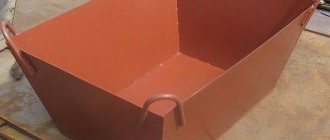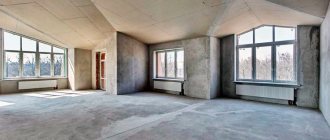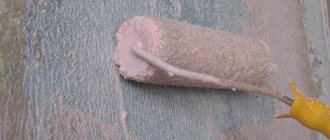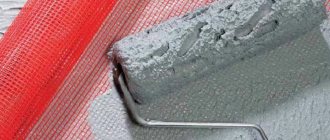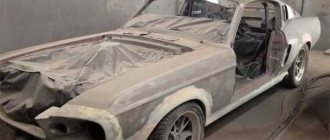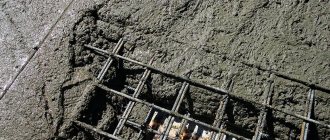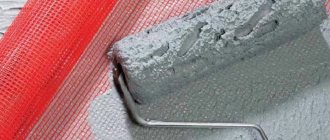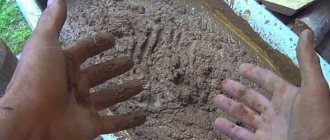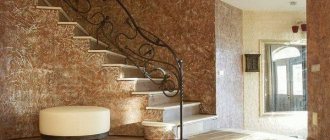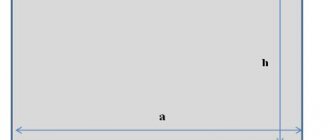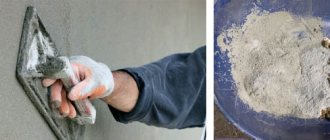For proper, and most importantly, less costly finishing work, the amount of necessary building materials should be pre-calculated. The consumption of plaster per 1 m2 has already been pre-determined by the manufacturer, and additionally the consumption rates were calculated and repeatedly tested back in the Soviet era and prescribed in SNiP. Simple calculations will help you quickly determine the required amount of material. More details about everything below.
What regulatory documents should be used when calculating
Standards for plastering walls were drawn up a long time ago and over the years have been repeatedly tested in practice by many builders. To determine the material consumption per 1 m2, only 2 regulatory documents are required, namely:
- SNiP 3.04.01-87. The standards have been drawn up specifically to determine the thickness and quality of both insulating and finishing coatings.
- Standard indicators of material consumption (NPRM) Collection 15.02 Plastering works. The collection is quite extensive and is recommended by the State Construction Committee of Russia as information material for the development of construction estimates. Standards and types of finishing materials for any surface are given.
Many of the data specified in SNiP 3.04.01-87 or in the more current version SP 71.13330.2017 are also in NPRM, but in an abbreviated version. No more regulatory documents are required to calculate consumption.
What does consumption depend on?
In addition to the type, material consumption depends on such an indicator as the curvature of the walls. If the walls of the room being finished deviate noticeably horizontally or vertically, are curved, and also have defects such as chips, fallen areas, etc., then the need for material may increase, sometimes noticeably. To minimize costs in this case, it is recommended to perform preliminary leveling with ordinary, non-decorative plaster.
When choosing a finishing coating, you need to take into account the material consumption and the nature of the walls that you plan to cover. Based on this data, you can calculate how much material is needed to complete the work and plan expenses.
Recommended conditions before starting work
The consumption indicated in the regulatory documentation is relevant for certain environmental conditions both indoors and outdoors. Before starting finishing work, you should make sure that:
- The room temperature is at least 10 C0. Air humidity – no more than 60%.
- The room is ready for plastering. To do this, it is necessary to maintain the nominal temperature in it for 2 days before work and 12 days after.
Preparation and plastering of a brick wall
Only if the above conditions are met, the consumption of plaster per 1 m2 will not exceed that stated in the regulatory documentation.
Permissible thickness of plaster layer
To determine such an important parameter as the permissible thickness of the plastered layer, you should look at Table 10 of SNiPa 3.04.01-87.
Technical requirements of the regulatory document:
- The layer thickness when plastering walls in one layer, for all categories of finishing materials except gypsum, should be 20 mm. When using gypsum-based solutions – 15 mm.
- Thickness at spray stone, brick, concrete walls in several layers - 5 mm. Wooden - no more than 9 mm.
The first stage of plastering. Spraying a concrete wall - When applying cement mortar-based soil Lime mortar (addition of gypsum is allowed) – 7 mm.
The covering layer when plastering the surface should be no more than 2 mm, but only if it is not a decorative finish - then it is allowed to make it 7 mm.
Calculation of the required amount of mixture
You can determine the required amount of material for plastering using this method. It is necessary to calculate the average layer thickness for a wall with an area of 12.5 m2. First, the wall is hung in several places; the more you do, the more accurate the result will be. The results obtained for the curvature of the wall, for example, 1, 4, 2 cm, must be added up and divided by the number of sags, in our case three. We get the middle layer (1+4+2)/3=2.33 cm.
Now you need to calculate the average consumption per square meter and the total amount of material. If you chose “Volma-layer” for plastering, which has a consumption of 9 kg/m2, then we get 9 * 2.33 = 20.97 kg, this is the average consumption. We multiply it by a total area of 12.5 m2, 12.5 * 20.97 = 262.1 kg.
The mixture is sold in 30 kg bags, so we calculate how many bags you need to buy: 262/30 = 8.73. We round up the resulting result and get 9 bags. Now it’s easier to calculate how much you need to spend to plaster a wall. You can use an online calculator to calculate.
How much is a square and linear meter?
We remember from our school geometry course that one square meter is a unit of area corresponding to the area of a square with sides one meter by one meter. Plasterers measure the area of walls, ceilings and facades in square meters.
A linear meter is a unit of measurement of the number of long objects, corresponding to a piece or section 1 meter long. When plastering door and window slopes, the plastering area is calculated in linear meters, without taking into account the width (depth) of the slope. Some plasterers also consider sections of walls up to 50-60 centimeters wide to be linear meters.
Mixture consumption per 1 m2 of surface
In the collection 15.02 NPRM you will find all the tables with consumption rates for various types of plaster (lime, cement, cement-lime mortar). For ease of understanding, its GOST is indicated next to the solution, and the consumption of mesh, plaster and dowels is also given. An inconvenience arises when calculating the amount of mixture per 1 m2, when the data is given in relation to 1 m3/100 m2 of area.
Consumption per 1 m2 with the condition that the material is applied in one layer (layer thickness - 1 cm):
- Plaster – 9 kg.
- Cement or cement-lime mortar – 17 kg.
- "Rotband". The main difference between the mixture and standard gypsum mortar is the presence of adhesion-improving additives. The consumption of the Rotband mixture per 1 m2 is 8.5 kg.
- "Bark beetle." "Bark beetle" is often used for finishing the facades of buildings and much less often - indoors. This type of plaster has several varieties, but on average its consumption is 3 kg per 1 m2.
- "Volma". Volma plaster is popular due to the variety of products - there are at least 22 types. One of the most common is “Volma-layer”, and its consumption ranges from 8 kg.
- Venetian plaster. It is more suitable as a filling option, since its layer should be very thin, so the consumption of the “Venetian” is as economical as possible: 200 g per 1 m2.
Consumption per square meter for some types of plasters - Vetonit. It is widely used due to its relatively low consumption. The composition of Vetonit mainly includes: cement (base), sand, limestone and microfiber. Consumption: 1.5 kg per 1 m2.
- "Teplon". Gypsum-based plaster is valued for its high environmental friendliness, affordability in terms of pricing policy and high-quality vapor permeability. Teplon consumption is 1.8 kg.
Important! If the surface is too deformed or there are cracks and potholes, you should add a certain amount of material to the already calculated one. Sometimes it is simply enough to round the estimate number up if it is not a whole number.
Factors influencing the amount of material
First of all, it is necessary to determine the factors that significantly affect the amount of gypsum plaster when leveling walls. Experts note the following main points:
- the curvature of the walls on which the plaster will be laid;
- the type of mixture that will be used and its texture.
It is important to take into account not only the vertical deviation of the wall, but also the horizontal one. Each of them affects the level of curvature of the walls, that is, changes in their directions from the norm.
In new houses that were built by professional builders, such deviations do not exceed 20-25 millimeters.
Moreover, in old buildings, self-constructions or new facilities built by people without experience, these indicators can be much more significant. In such cases, not only will it be necessary to spend a lot of plaster for leveling, but it may also be difficult to even install beacons along which this process will be carried out.
The type of mixture also affects its consumption, since each of them has its own individual characteristics and technological standards determined by the manufacturer. Departure from these standards may threaten the material’s failure to fulfill its functions, which provokes further problems with the wall.
Before calculating the amount of plaster that will be needed, you must thoroughly clean the wall of everything.
Wall cleaning
After this, special beacons are installed , which serve as points to which the solution should be applied to the surface.
Installation of beacons
It is necessary to measure the distance from the wall to the extreme points of the beacons, then add all the results obtained and divide by their total number. This number will be the average thickness of the mixture that will need to be applied to the surface.
After this, you need to find out what the consumption rate of gypsum plaster per 1 m2 is from the selected manufacturer , and make a more accurate calculation. Depending on the thickness of the plaster layer, its drying time will depend.
Gypsum plaster according to GOST
Nowadays, the most popular mixtures for plastering premises are made on the basis of such a universal building material as gypsum. But not all manufacturing companies, due to the constant savings in component materials, strictly follow the letter of GOST. The main regulatory document that precisely specifies the requirements for the production of gypsum mixture is GOST R 57957-2017.
The following are available in GOST:
- Notation.
- Types of gypsum plasters.
- Labeling and packaging.
- Thermal conductivity values of the material after it hardens.
Composition of gypsum plaster
But most often, buyers are not interested in the composition of the plaster, but in its proportions. To find out the components of a dry gypsum mixture, just look at GOST 31377-2008, which consistently describes all the requirements for this product:
- The dry mixture must not contain grains larger than 5 mm. GOST allows the presence of grains measuring 1.25 mm - no more than 1%, 0.2 cm - no more than 12% and 0.125 - no more than 15%.
- Gypsum, which is added to the dry mixture, must be made in accordance with GOST 125.
- After adding water to the dry mixture, the resulting solution should set during manual application in at least 45 minutes. When using any application technique - no less than 90 minutes.
- The water holding capacity should not be less than 95%.
Important! If this GOST is indicated on the box of the purchased mixture, but the quality of the plaster, its hardening time or other characteristics do not meet the requirements of the regulatory document, then each buyer has the right to receive monetary compensation.
Plaster Knauf Rotband
Knauf Rotband is very popular among craftsmen and finishers. Firstly, because of its versatility (suitable for concrete, brick, cement surfaces, as well as gypsum partitions). Secondly, because of its affordable price.
When purchasing Knauf-Rotband plaster, you should not pay attention to its color, since similar products can be white, gray or pink. Different colors and shades of the mixture are given by polymer additives, which are mixed with the main ingredients specifically to give good stickiness to the finished solution.
The consumption of Rotband is much less than cement-based solutions, since gypsum predominates in these products. 8.5 kg of mixture is enough to cover an area of 1 mm2. A layer 1 cm thick dries in no more than 1 hour, but to fully gain strength, the plaster should be allowed to sit for at least 7 days.
Gypsum solutions are capricious in some nuances, so Rotband has several minor drawbacks:
- A layer of Rotband plaster is inferior in strength to the same layer, but based on a cement component.
- It quickly enters into a process with metal parts (nails, screws, screws, self-tapping screws), which leads to their rust. Therefore, yellow stains may appear on the plastered surface over time.
- It is best not to apply Rotband in areas with high humidity.
Important! The building materials market is filled with fakes, which in appearance and cost are practically no different from the original. The main feature of Knauf Rotband unnatural plaster is the presence of sand in the packaging. Such a product should be returned to the seller immediately!
Types of leveling plasters
Plasters for leveling walls are usually divided into:
- Plaster;
- Cement (cement-sand);
- Cement-lime;
- Clay.
The choice of composition will depend on operating conditions and budget.
Gypsum plasters are used in dry rooms. For facade work, applications in bathrooms are not suitable, since gypsum absorbs moisture from the air. The cost of gypsum plasters is higher than that of cement-based mixtures. Gypsum mixtures are easy to apply, flexible, and can be glossed, which makes it possible to avoid further preparation for wallpaper. They dry quickly, which speeds up work, but at the same time limits the volume of mixture mixed at one time (the prepared volume must be used within 40 minutes). Gypsum plasters for wet rooms contain hydrophobic additives; it is these compounds that are used to level the ceiling in the bathroom.
To save money, cement-based plasters are often made independently on a construction site, but ready-made dry mixtures are also available for sale. It has greater density and higher strength characteristics than gypsum. Used for facade work, in unheated utility rooms and in wet rooms. To level walls in bathrooms and other wet rooms, lime is added to cement-sand mixtures to form cement-lime mixtures. Cement plasters are less plastic; for painting or wallpaper they require putty to level the surface; they take longer to dry, this allows you to prepare large volumes at once, but the waiting time between coats increases.
Clay plasters can be used indoors and outdoors, in dry and wet conditions. The elasticity of clay allows the compositions to retain their properties during strong heating or cooling, which is why such compositions are most often used on fireplaces and chimneys. The ability of the mixture to absorb moisture and then release it outside makes the composition ideal for leveling wooden walls.
